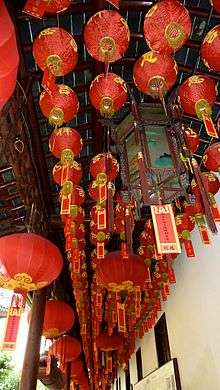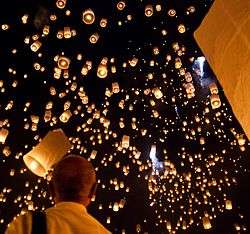Paper lantern

A paper lantern is a lantern made of thin, brightly colored paper.[1] Paper lanterns come in various shapes and sizes, as well as various methods of construction. In their simplest form, they are simply a paper bag with a candle placed inside, although more complicated lanterns consist of a collapsible bamboo or metal frame of hoops covered with tough paper. Sometimes, other lanterns can be made out of colored silk (usually red) or vinyl. Silk lanterns are also collapsible with a metal expander and are decorated with Chinese characters and/or designs. The vinyl lanterns are more durable; they can resist rain, sunlight, and wind. Paper lanterns do not last very long, they soon break, and silk lanterns last longer. The gold paper on them will soon fade away to a pale white, and the red silk will become a mix between pink and red.
History
There does not appear to be any authoritative publication on the history or origin of the paper lantern available to the lay researcher (via Google.com, Wikipedia.org & Google Scholar searches, i.e.). In fact, until the publication of an updated scholarship in 2016, the most recent academic quality research on the more fundamental subject of the history of paper was a volume in an edited series on Chinese technology and invention first published in 1949.[2][3] This volume, however, copyrighted the inevitable conclusions derived from recent discoveries that fundamentally changed the inherited story of paper, reordering our understanding of how and why this material came to be a fundamental medium for the transmission and understanding of human society.[3]
Paper, it appears, was used for a wide variety of decorative and commercial functions (including the manufacture of lanterns) for more than two hundred years before the famous innovator Cai Lun, previously revered as the inventor of paper in Chinese history, popularized its use as a medium for the recording of general information.[4] While writing appears on the oldest known samples of paper, as labeling, advertising and prayer, it appears that Cai Lun’s contribution to the story of paper is in generalizing this use for all types of knowledge and records.[2]
It is, however, in these original uses of paper as medium for advertisement and prayer that the Chinese paper lantern first found its light. Before books were ever written on paper (wood or bamboo blocks were the preferred material for general knowledge and record-keeping at the time), the hopes and dreams of Chinese Buddhists were signified in the light of paper lanterns, often decorated with the stylized characters which communicated those thoughts to those who could not bear audial witness to their formation.[5] To these Buddhist monks of the early Han Dynasty, roughly one hundred and fifty years before the epoch defining deaths of Caesar Augustus and Jesus of Nazareth, the glow of candlelight within the paper walls of the lantern became a miniature version of the bonfires, lit with the walls of their fortress abbeys on ceremonial occasions, which, in turn, symbolized the light of their pious thoughts, emanating outward to illuminate the ignorance of the unenlightened world. As they studied and recorded and analyzed the world around them, protected from the harsh opinions of the wild world by the walls of their fortresses, so did the candle consume its fuel, sheltered from the winds while projecting its light to the world beyond.
Though the legend became confused and convoluted as Chinese historians came to settle on a narrative of Cai Lun as inventor and not simply innovator of paper technology, it appears that an early Emperor of the Eastern Han Dynasty celebrated the establishment of a new era in his reign, or perhaps simply the return of an embassy to India, by adopting the sacred symbol of the Buddhist lantern for his secular celebration, commanding that the lanterns be burned across the capital city, Luoyang. When the necessity of keeping faith with the representation of Cai Lun as inventor can be ignored, this Emperor is said to have been Ming-ti (Han Mingdi), who welcomed two Buddhist monks to his court alongside his returning ambassadors in the year 67 of the Common Era.[6][7] Others, however, attribute this adaptation to the earlier, unified Han Dynasty Emperor Wu (Han Wudi), who is known for establishing these new eras in his reign every few years and also sent embassies to India, though history, Chinese or Academic, does not record the return of these efforts, except in the possibility of connection to the legend of secular lantern lighting.[7]
Over the two thousand years that have transpired since, the lighting of paper lanterns has become a traditional part of Chinese celebrations of all kinds and has been passed to neighboring cultures from Japan to Southeast Asia. In many places across Eastern Asia, this tradition is most developed in a festival devoted especially to the launch of paper lanterns into the air (as primitive hot air ‘balloons’) or upon a body of water, with their original prayerful or aspirational purpose, that of carrying painted prayers or, more rarely, as purely symbolic manifestations of those wishes.[6]
More commonly, however, paper lanterns serve their other early purpose, that of advertisement as the earliest form of lighted signage.[2] While this purpose followed closely the adaptation from religious to secular celebration, it is today, the most common and visible use of these beautiful and graceful objects in everyday life around the world, particularly in cities in Eastern Asia and in ‘Chinatown’ neighborhoods worldwide, where they are commonly found as part of the decorative marketing of restaurants and shops of every sort.
In Asian culture


Often associated with festivals, paper lanterns are common in China (Palace lantern), Korea, Japan, Vietnam, Thailand, Myanmar, Sri Lanka, Cambodia, India, Singapore and Malaysia and, similarly, in Chinatowns, where they are often hung outside of businesses to attract attention. In Japan the traditional styles include bonbori and chōchin and there is a special style of lettering called chōchin moji used to write on them.
Airborne paper lanterns are called sky lanterns, and are often released into the night sky for aesthetic effect at lantern festivals.
In China, paper lanterns can be classified into 5 distinct classes; the Baby's Bottom is the miniature class, often used in modern times with Christmas lights. The second class is the Rolling Paper, the tall, cylindrical lanterns often associated with restaurants and bars. The third class is the Tomato Light also known as Big Red; the classic round mid-size lantern. The fourth class is the Crystal Magic; the variously-shaped geometric lamps constructed of many square and triangular panes. The last is known as Buddha's Gastronomy; the large and extra large lanterns used to decorate temples and for show at festivals. Also, there are the traditional Chinese lanterns, primarily red but also in other colours, that can be round or capsule-shaped, usually seen in stores, at temples, or during festivals. The color red (fire) traditionally symbolizes good fortune and joy.
In Western culture

Placing candles or tea lights in a succession of small paper bags (known as luminarias or farolitos) is a common tradition in Hispanic communities during Christmas.
During the Festa della Rificolona held in Florence, Italy, children carry colourful paper lanterns through the streets of the city.
In Germany, Austria, Switzerland and other German-speaking and some Dutch-speaking parts of Europe there is a tradition of the Sankt-Martins-Umzug, (Sint-Maarten in Dutch) during which children parade with paper lanterns that are traditionally handmade.
In photography
High-wattage paper lanterns are commonly used in lighting for motion picture productions. Commonly referred to as "China balls", they provide soft, edgeless light to a scene.[8]
See also
References
- ↑ "Chinese lantern". The Free Dictionary. Retrieved 18 May 2014.
- 1 2 3 Kurlansky, Mark (2016). Paper. W. W. Norton & Company. Chapter 2.
- 1 2 Tsien, Tsuen-Hsuin. Needham, Joseph, ed. Paper and Printing. Science and Civilisation in China, Chemistry and Chemical Technology. Vol. 5, Part 1. Cambridge University Press. p. 38.
- ↑ "Formation of the Chinese Civilization - china.org.cn". www.china.org.cn. Retrieved 2017-12-09.
- ↑ Xiang, Bo-song (2000). "A New Research into the Origin and Cultural Connotation of the Lantern Festival". Journal of South-Central University For Nationalities (Philosophy and Social Science) (2).
- 1 2 Huang, Shaorong (Winter 1991). "Chinese traditional festivals". Journal of Popular Culture. 25 (3) – via ProQuest.
- 1 2 Beal, Samuel (1884). Buddhism in China. Bowling Green, Ohio: Society for Promoting Christian Knowledge. pp. 42–50.
- ↑ Ballinger, Alexander (2004). New Cinematographers. Laurence King Publishing. p. 186. ISBN 1-85669-334-1.
| Wikimedia Commons has media related to Paper lanterns. |